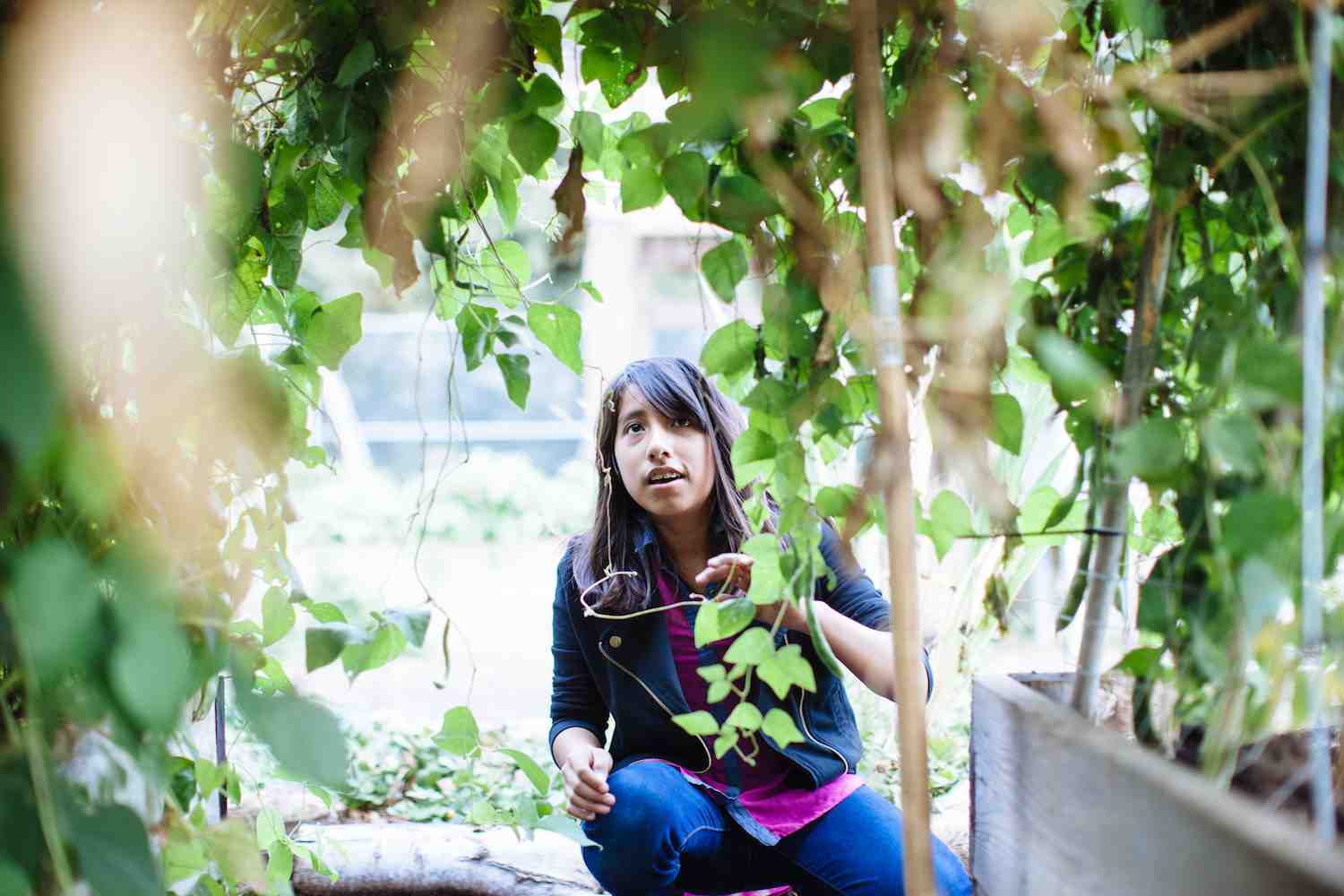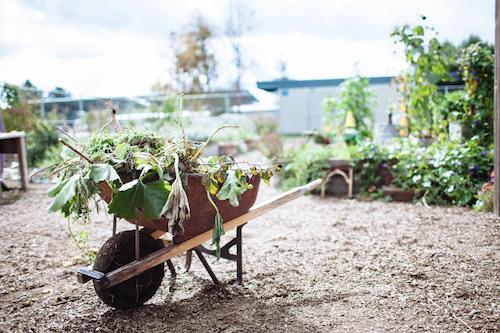The school garden movement could end diabetes and does provide Common Core curriculum. So why is it still viewed as a hippie’s daydream?
On a sunny Friday morning in the Wright Charter School garden, first graders bustle about between rows of lettuce, dried sunflowers, corn, scarlet runner beans, and cabbage. The students tease and jostle, watering and tending plants. The scene looks straight from Anne of Green Gables or any one of those other classics about the simple pleasures of rural life. But this isn’t 19th century Nova Scotia and no one, except possibly the scarecrow, wears calico. These kids live in Roseland, a low-income, unincorporated area of Sonoma County, where high-density housing and little access to parks and open space is the norm.
The class settles around a garden box stuffed with tall, green stalks. Garden coordinator Julia Valentine gives a short lesson on harvesting (don’t tug violently to get the carrots out of the soil), and then gives the go. The kids dive in, digging up chunky carrots that are absolutely ready for the dinner table. “Look what I found!” says a dark-haired girl, holding up a set of spindly orange twins. “I see a roly-poly!” exclaims another child. They scoot between box and bucket, until the pile of carrots overflows.
Later, a different class will hold a carrot tasting, or maybe use them in a simple recipe, with Valentine’s guidance. It’s all part of the daily cycle at the Wright Charter School garden, on the outskirts of Roseland in one of the oldest school districts in Sonoma County. A few years back, Wright became a public-charter school with a focus on eco-literacy and environmental education, a philosophy into which growing a school garden fits nicely.
Students who grow, harvest, and eat their own produce will eat anything. Laurel Anderson
“A lot of these kids don’t get to spend much time outdoors,” Valentine says. “It’s important for all children to have a notion of what the earth holds for them and where their food comes from, but the kids have very few opportunities to interact with their natural environment. The garden allows them to freely explore and open their five senses to the natural world.”
Liz Macdonald teaches second grade at Wright. “The kids absolutely love the garden,” she says. “They love getting in there and digging with their hands, and holding a shovel, or exploring for snails and harvesting.”
“They love building practical skills,” Valentine adds.
MacDonald recalls bringing a cucumber back from the garden with her class, which they cut it up and ate immediately. “The fact that we picked something from the garden and brought it straight to the class and directly to their mouths—they just loved it,” she says.
For anyone born after 1960, school gardens probably seem like a new concept. But they’ve actually been around for generations. Throw a pencil in the Library of Congress and it’ll probably land on a quote from a Victorian-era educator touting the benefits of fresh air, physical exercise, and the character-building and educational aspects of “nature study.”
But school gardens were lost to time after the post-war industrial boom brought processed food into every home along with a host of health maladies. Since the 1970s, the percentage of overweight and obese children in the United States has tripled. One in three children born in the year 2000 has the chance of developing Type II diabetes. These numbers are most concentrated in low-income communities. The cause behind these startling statistics is clear. Children eat too many processed, fat-filled foods and too few vegetables and fruits. Just two percent of children in the U.S. eat an appropriate amount of fruits and vegetables daily, according to the Whole Kids Foundation.
“A lot of these children are so disempowered because of their demographics,” Valentine says. “Giving them this capacity to know where their food comes from, how to propagate it, it’s a tool for their future.”
She adds, “Harnessing their food system is kind of the most radical act that they can engage in.”
Her claim is held up by data. The Whole Kids Foundation says that children who grow their own food are more likely to eat fruits and vegetables and to be more knowledgeable about nutrition. These habits continue into adulthood. People who garden and grow food as adults almost always have vivid memories of playing and working in gardens as children, according to 2007 study by researchers at the University of Colorado.
The Sonoma County Health Action Plan has set the goal of raising the amount of children eating their appropriate daily allotment of fruits and vegetables to 75 percent. Might a garden in every school be just the ticket to achieve this ambitious number?
Yes, says Laurel Anderson, Schoolyard Habitat coordinator and board member at the School Garden Network (SGN). The organization formed in 2003 as a response to former California State Superintendent Delaine Eastin’s call to put a “garden in every school.” SGN has since developed into the largest school garden grant funding organization in Sonoma County. They’ve awarded over $120,000 in funding to 22 local schools. Along with salad bar and school garden grants, the organization offers mentorship, community connections, workshops, and free plants and seeds to sustainable garden and nutrition-based learning programs to students and educators.
A desire to connect garden coordinators and facilitate easy resource sharing was another driving force behind SGN’s creation. Garden coordinators—ideally ones who can spend more than just a few hours a week teaching—who fundraise and network with the administration, its teachers, and the students’ parents, are essential to the long-term success of school gardens.
These are also the hardest positions
to fund.
“It’s difficult for the schools to come up with that money, and it’s difficult to find grants to fund coordinator positions,” Anderson says. As a result, gardens are sometimes dependent on volunteers or, more challenging—on already overworked teachers. “The garden needs a staff person to coordinate it,” Anderson says.
For that reason, convincing school and districts to see the importance of school gardens, nutritionally and academically, remains a challenge.
Yet the simplicity of working in and eating from a garden offers students the opportunity to engage in real-world, inquiry-based learning. “You can read about a life cycle in a textbook, but if you go out into the garden and see the ladybug cycles or worms in the compost bin, it becomes an experiential learning situation that creates so much enthusiasm in the students,” Anderson says. “It’s a fabulous springboard for their classroom studies.”
Row upon row of school garden displays at the recent National Heirloom Exposition demonstrated the wealth of ways students learn in plots across Sonoma County. They measure seeds. They write sentences using the garden as inspiration. They perform complex math equations. Even art classes have gotten in on the action, sending students out to sketch flowers and paint lettuce.
As the founding garden coordinator at Salmon Creek School in Occidental, Anderson saw these benefits first-hand, especially as related to cooking and nutrition. Students learn about the abundance and limitations of their local food shed, she says. They learn why they can’t make fresh salsa in March and how good kale can taste when you grow and pick it yourself.
“Students who grow, harvest, and eat their own produce will eat anything in my experience,” Anderson laughs. “They wolf it down.”
What’s more, Anderson says, “They really learn to value and appreciate seasonal, fresh, and whole foods simply prepared.” Parents get motivated to cook more healthily, too, influenced by kids who want to make the same healthy recipes they learned at school at home. And students get a chance to learn skills lost to the industrialization and outsourcing of food to large corporations, gaining an empowerment and pride they might not have otherwise.
The Salmon Creek school garden has become a model for other programs. The Occidental Arts and Ecology Center brings in trainees from its School Garden Teacher Training and Support Program to see how they make it work.
Nestled on a one-acre plot west of the public-charter school campus and bracketed between redwood-covered hills and the restored Salmon Creek watershed, the word idyllic doesn’t do the scene justice.
A tour with outgoing garden coordinator Erin O’Brien and her incoming replacement Kaelyn Ramsden, who’s been on the job all of a week, offers the opportunity to taste sun-warmed strawberries straight off the plant. That’s not all. Sweet and juicy Sungolds are heaven on a vine. Even in late summer, the garden produces like mad. There’s blue corn (grown from seeds gifted from a Zapatista village school), tree collards, lettuce, and heirloom tomatoes. Just that week, Ramsden had harvested cherry tomatoes, peppers, zucchini, and cucumbers, amongst other things, as she prepared for the start of classes. Nearly all of the produce, aside from the yield that goes to 24 bimonthly CSA boxes, ends up in the cafeteria, where the school chef creates seasonally influenced lunches. That’s unusual. Most school gardens just don’t produce enough to feed the entire school. Here, a few hundred students get to eat the food they grow. Plus, cooking classes allow the kids themselves to learn how to make the bounty into something delicious, like the blue-corn pancakes that have become a campus favorite.
Students who grow, harvest, and eat their own produce will eat anything. Laurel Anderson
This year, the program is focused on deepening the connection between the garden and the cafeteria, says O’Brien, as she leads our small garden tour through raspberry patches, persimmon trees, and a small apple orchard, planted and grafted by the students.
Soon, we arrive at the “fairy garden.” This is the place where the younger kids frolic among roses, mulberry, and willows. A miniature table and chairs sit beneath an umbrella of willows, the perfect place for a tea party. An old-fashioned water pump looks straight out of Little House on the Prairie.
Next to a bubbling brook, kindergartners build huts out of dropped tree branches, says O’Brien. “It gets them away from plastic toys,” she adds.
With the older classes, the coordinators balance workdays—when the kids sift compost, weed, and harvest—with play days. “The play becomes their reward for hard work,” says Ramsden. It’s not just about manual labor—although the exercise does a body good. The students are out here, thinking and studying. They examine the nesting behaviors of bluebirds with a local bird scientist. They learn about life cycles, decomposition, and seed-saving—all of which takes some of the weight of teaching California Common Core standards off the teachers’ shoulders.
“The hands-on activities can lead directly to aha moments,” says O’Brien, recalling a lesson that used pumpkin spikes to teach adaptation.
As the tour winds down, Ramsden, still young herself, looks back to history, recalling how everything old is new again.
“School gardens aren’t these hippy-dippy, New Age things that have only been around for 20 years,” she says. “They have been around since the 19th century. Back then, it was just considered common sense.”
But, with the growth and support for school gardens in Sonoma County, thanks in part to the School Garden Network, it looks like they’re becoming a common sense addition to school curricula once again.



